How AI Can Help Organizations Achieve Pay Equity in 2025

Pay equity ensures employees receive fair compensation for equal work, regardless of gender, race, or other factors. It fosters transparency and fairness, which directly impacts employee satisfaction and engagement. However, achieving pay equity remains a challenge. Many organizations struggle with inconsistent salary monitoring, outdated practices, and unclear benchmarks for improvement.
AI for pay equity analysis offers a transformative solution. By leveraging data-driven tools, companies can identify disparities, conduct automated audits, and implement predictive analytics. These advancements not only reduce bias but also help organizations comply with evolving pay transparency laws across the U.S.
Challenges in Achieving Pay Equity
Unconscious Bias in Salary Decisions
Unconscious bias often influences salary decisions, even when organizations aim for fairness. You may not realize how deeply ingrained stereotypes can affect pay offers. For example, studies show that men are frequently offered higher initial salaries compared to women, especially during hiring negotiations. This bias becomes even more pronounced for women of color, who face larger wage gaps.
A recent survey revealed that 51% of employees believe bias impacts pay decisions, yet only 43% of HR teams have programs to reduce bias in performance reviews. Additionally, over 60% of employees remain unaware of HR leveraging technology to address pay disparities. These statistics highlight the need for proactive measures, such as using AI tools to identify and mitigate unconscious bias in salary practices.
Lack of Transparency in Pay Structures
Hidden pay structures create confusion and mistrust among employees. Without clear communication about compensation frameworks, you may struggle to understand how salaries are determined. Transparent pay practices, however, can foster trust and improve retention rates. Companies with open salary policies report 25% lower turnover rates, showing the positive impact of transparency on employee satisfaction.
To implement transparency effectively, organizations should align salaries with industry standards through market research. Involving employees in decision-making processes and sharing success metrics related to pay equity can further enhance trust. Monitoring diversity in leadership roles and conducting regular surveys on fairness perceptions are additional steps you can take to ensure transparency.
Outdated HR Practices
Outdated HR practices often hinder progress toward pay equity. Many organizations conduct pay audits, but only 54% review salaries annually. This inconsistency allows inequities to persist. Furthermore, less than half of HR leaders provide clear compensation information, and 43% fail to share pay band details.
The gender pay gap remains a significant issue, with women in some sectors earning as little as 63.8% of their male counterparts' wages. Modernizing HR systems and adopting AI-driven tools can help you address these challenges. By automating pay audits and ensuring real-time monitoring, you can create a fairer and more equitable workplace.
Identifying systemic disparities
Systemic disparities in pay often go unnoticed without a structured approach to uncover them. These disparities arise when certain groups consistently earn less than others due to ingrained practices or policies. You can address this issue by analyzing patterns in compensation data and identifying gaps that affect specific demographics.
AI tools excel at detecting these hidden inequities. By analyzing large datasets, AI can highlight trends that might otherwise remain invisible. For example, it can reveal if employees in similar roles receive different pay based on gender, race, or other factors. This insight allows you to take corrective action and ensure fair compensation for everyone.
Several organizations have already taken steps to identify and address systemic disparities.
Salesforce conducted a comprehensive pay audit and discovered that 9% of its employees were underpaid compared to their peers. The company committed over $16 million to rectify these disparities, demonstrating the power of data-driven solutions.
Buffer adopted open-salary transparency, making all employee salaries accessible. This approach encouraged discussions about pay equity and significantly reduced gender pay gaps. It also showed how accessible data can promote fairness and accountability.
You can learn from these examples by prioritizing transparency and leveraging technology. Start by conducting regular pay audits and sharing the results with your team. Use AI to analyze compensation trends and identify areas for improvement. When you address systemic disparities, you create a workplace where fairness and trust thrive.
AI for Pay Equity Analysis

Automated Pay Audits
Automated pay audits simplify the process of identifying salary disparities. By using AI tools, you can analyze large datasets quickly and accurately. These tools detect patterns and anomalies in pay structures, ensuring compliance with regulations and reducing the risk of human error. For example, organizations with mature AI systems achieve 40% faster compliance reporting and 98% data accuracy through automated validation.
A study published in the Harvard Business Review highlights how AI-powered compensation systems improve transparency and fairness. Companies using these systems report a 25% decrease in gender pay gaps within two review cycles. The table below illustrates the quantitative benefits of automated pay audits:
Metric | Result |
|---|---|
Compliance reporting speed | 40% faster |
Improvement in identifying pay gaps | 38% improvement |
Data accuracy through automation | 98% accuracy |
Reduction in HR workload | 35% reduction |
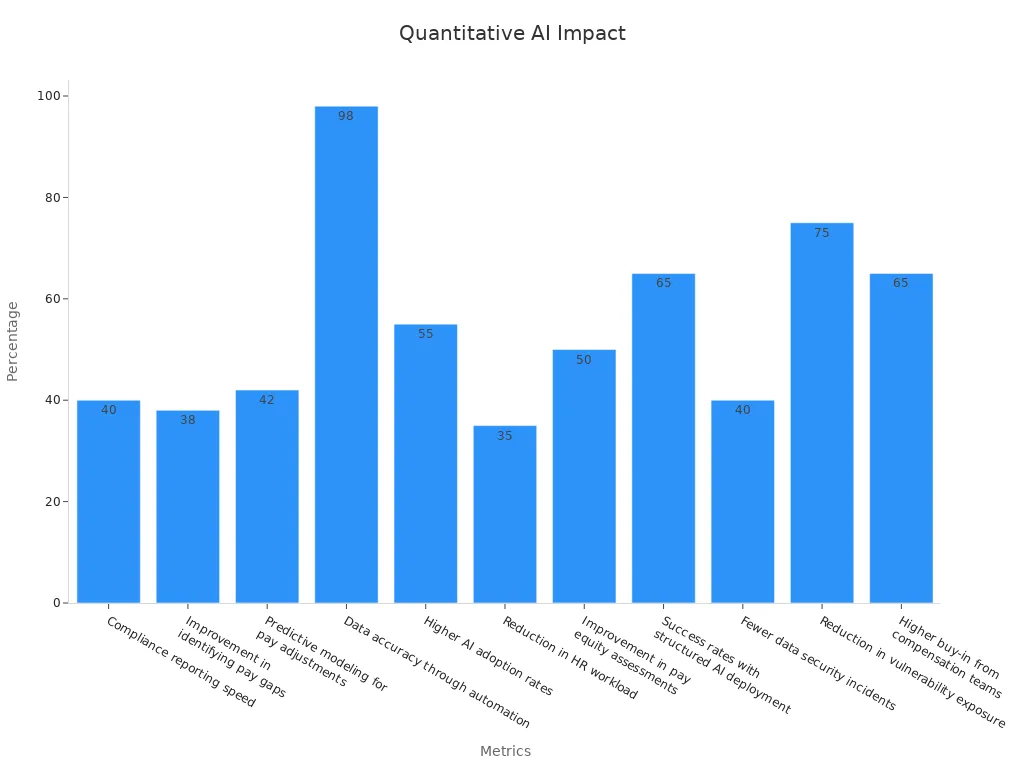
Predictive Analytics for Salary Adjustments
Predictive analytics helps you make informed salary adjustments by forecasting future trends. AI tools analyze historical compensation data and external market indicators to predict salary benchmarks. This ensures your organization remains competitive in attracting and retaining talent. For instance, Salesforce used predictive analytics to align salaries with market trends, enhancing their talent acquisition efforts.
Organizations using predictive analytics adapt to market changes 30% faster, according to Gartner. These tools also help you plan budgets and total rewards programs effectively. By identifying patterns in compensation data, you can address pay disparities proactively and ensure fair compensation for all employees.
Continuous Monitoring of Pay Practices
Continuous monitoring ensures that pay practices remain equitable over time. AI systems provide real-time insights into salary data, allowing you to identify and address disparities as they arise. These systems achieve over 95% accuracy in salary analysis and respond to queries in under three seconds.
By leveraging AI for pay equity analysis, you can maintain compliance with regulations and improve employee trust. Companies using AI for continuous monitoring report an 85% positive sentiment among stakeholders and a 31% increase in employee retention. Regular monitoring also reduces the risk of systemic disparities, creating a fairer workplace for everyone.
Data-driven decision-making to reduce bias
Data-driven decision-making empowers you to reduce salary bias by relying on facts rather than assumptions. By analyzing compensation data, you can uncover patterns and trends that might otherwise go unnoticed. This approach ensures fairness and helps you make informed adjustments to salary structures.
Organizations that embrace data-driven strategies often see remarkable results. For example:
Companies focused on data-driven decision-making report 23% higher profitability and 9% higher productivity.
A Deloitte study revealed that using machine learning for compensation assessments led to a 12% increase in employee retention rates.
Advanced analytics in salary management improved diversity hiring outcomes by 25% and reduced pay disparities by 20% over three years.
Real-world examples highlight the effectiveness of this approach. A tech startup used AI to analyze salary data and found that female engineers earned 15% less than their male counterparts. By applying predictive analytics, the company corrected this gap and boosted employee satisfaction scores by 30%. Similarly, an HR manager named Alex used data analytics tools to audit salary ranges. This effort uncovered hidden discrepancies, leading to a 15% improvement in employee retention and morale.
AI for pay equity analysis plays a crucial role in this process. It enables you to evaluate large datasets quickly and accurately, ensuring that decisions are based on objective insights. By leveraging these tools, you can identify inequities, implement corrective measures, and foster a culture of fairness. Data-driven decision-making not only reduces bias but also strengthens trust and transparency within your organization.
Tip: Regularly review your compensation data to ensure ongoing equity. Consistent monitoring helps you stay ahead of potential disparities and maintain a fair workplace.
Benefits of AI-Driven Pay Equity Solutions
Enhanced Transparency and Trust
AI tools bring unparalleled transparency to salary management. By analyzing vast datasets, these tools uncover hidden pay gaps and ensure fair compensation practices. For example, Salesforce used AI to identify a 19% pay gap between male and female employees. This led to salary adjustments and ongoing monitoring, which significantly improved trust among employees. Similarly, Unilever achieved 99% pay equity by leveraging AI, resulting in a 10% boost in employee engagement scores.
Transparent pay practices foster trust and accountability. Employees feel valued when they see clear, data-backed decisions about their compensation. AI systems also enable organizations to share insights about pay equity progress, further enhancing trust.
Improved Fairness and Compliance
AI for pay equity analysis ensures fairness by detecting and addressing pay disparities with precision. These tools improve the accuracy of pay disparity detection by 65% and reduce pay calculation errors by 92%. Faster implementation of salary benchmarking—up to 55% quicker—helps organizations stay ahead of regulatory requirements.
The table below highlights key improvements achieved through AI-driven solutions:
Improvement Metric | Percentage Improvement |
|---|---|
Accuracy in pay disparity detection | 65% |
Reduction in pay calculation errors | 92% |
Faster implementation of salary benchmarking | 55% |
Higher trust in compensation decisions | 60% |
Compliance with GDPR, CCPA, and EEOC | 100% |
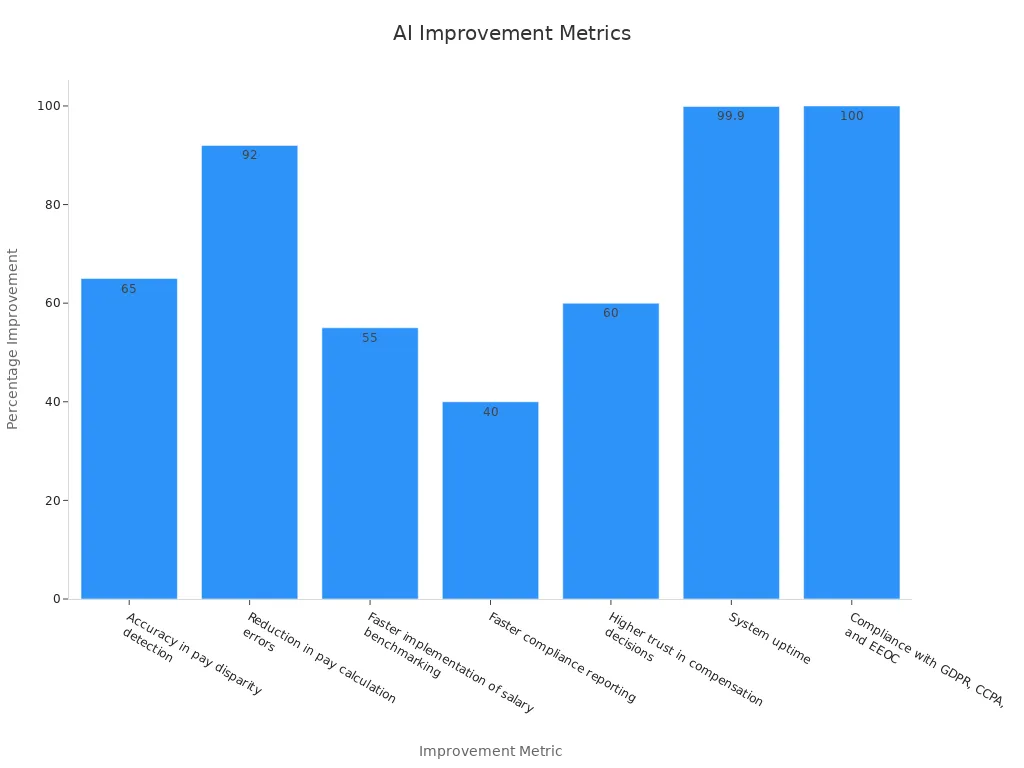
By ensuring compliance with laws like GDPR and EEOC, AI tools protect organizations from legal risks. They also build confidence among employees, who trust that their pay aligns with industry standards and legal requirements.
Increased Employee Satisfaction
Fair pay practices directly impact employee satisfaction. Organizations that prioritize pay equity see a 20% improvement in employee satisfaction and retention rates. For instance, Netflix reported a 40% increase in satisfaction after implementing AI-driven fairness measures.
AI systems also streamline salary adjustments, ensuring employees feel recognized and valued. A study from the Journal of Business and Psychology found that 75% of organizations using AI in compensation experienced improved satisfaction with remuneration.
The benefits extend beyond individual employees. Higher satisfaction levels contribute to a positive workplace culture, where employees feel motivated and engaged. By addressing pay disparities proactively, you create an environment where everyone thrives.
Streamlined HR processes
AI transforms HR processes by making them faster, more accurate, and less labor-intensive. When you use AI tools for pay equity, you eliminate manual errors and reduce the time spent on administrative tasks. These tools automate repetitive tasks like salary benchmarking and payroll adjustments, freeing up your HR team to focus on strategic initiatives.
Organizations that adopt AI-driven HR systems report significant improvements in efficiency. For example, automated systems reduce pay calculation errors by 92%, ensuring employees receive accurate compensation. Faster salary adjustment cycles—improved by 33%—help you respond quickly to market changes or internal equity concerns. Additionally, payroll team productivity increases by 47%, allowing your HR department to handle larger workloads without additional resources.
Metric | Value |
|---|---|
Reduction in pay calculation errors | 92% |
Faster implementation of salary benchmarking | 55% |
Increased payroll team productivity | 47% |
Faster salary adjustment cycles | 33% |
Higher trust in compensation decisions | 60% |
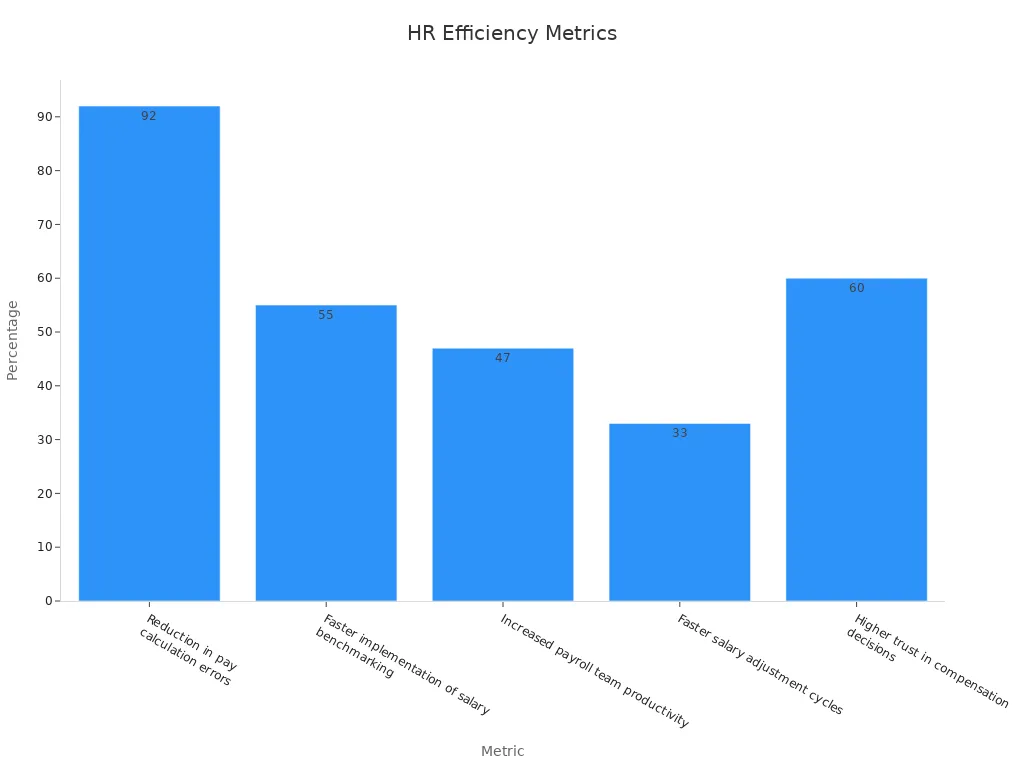
AI also streamlines administrative tasks, reducing the time spent on these activities by 25%. This efficiency allows you to focus on improving employee satisfaction and retention. Companies using AI for HR processes report a 40% increase in employee satisfaction and a 30% boost in overall productivity.
Metric | Value |
|---|---|
Increase in employee satisfaction | 40% |
Boost in productivity | 30% |
By integrating AI into your HR systems, you create a more efficient and equitable workplace. Employees trust compensation decisions when they see data-backed processes in action. This trust fosters a positive work environment, where fairness and transparency drive engagement and loyalty.
Tip: Use AI tools to automate routine HR tasks. This approach saves time and ensures your team can focus on building a culture of equity and trust.
Real-World Applications of AI in Pay Equity

Case study: AI-powered pay audits in a tech company
Tech companies often face challenges in achieving pay equity due to complex salary structures and rapid workforce growth. One notable example is Salesforce, which conducted a comprehensive review of its pay structures in 2018. The company discovered that female employees earned 19% less than their male counterparts on average. By implementing AI for pay equity analysis, Salesforce adjusted salaries and established continuous monitoring systems. This approach not only closed the wage gap but also fostered trust and transparency among employees.
Organizations with mature AI systems achieve significant improvements in pay equity outcomes. For instance, companies with robust data governance frameworks report a 38% improvement in identifying pay gaps. Additionally, integrating AI-powered compensation platforms increases pay transparency by 46%. These results highlight the transformative potential of AI in addressing systemic disparities.
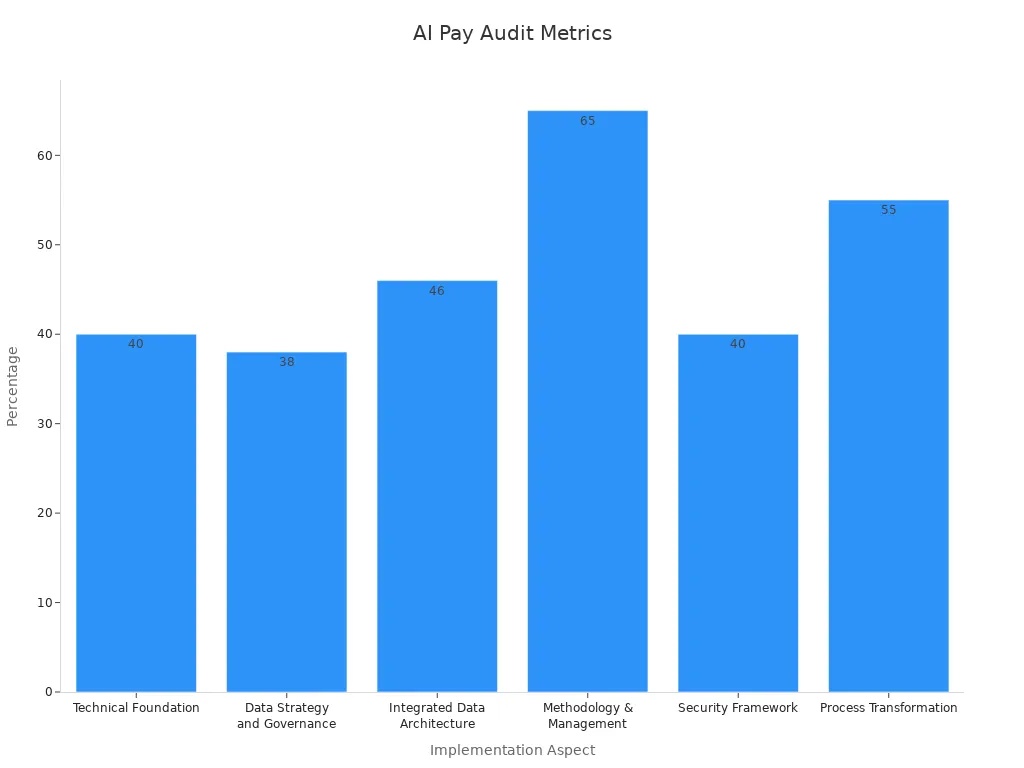
Example: Predictive analytics in retail salary management
Retail companies often struggle with high employee turnover and inconsistent salary structures. Predictive analytics offers a solution by forecasting salary trends and identifying disparities. For example, Uniqlo used data-driven compensation strategies to reduce pay disparities by 20%. This initiative also led to a 15% surge in sales figures and a 30% improvement in employee satisfaction scores.
A Deloitte study revealed that companies leveraging predictive analytics are 4.5 times more likely to be high-performing. These tools also improve diversity hiring outcomes by 25% and increase employee retention rates by 10%. By adopting predictive analytics, you can ensure fair compensation while enhancing overall business performance.
Insights from industries adopting AI for pay equity
Industries across the globe are embracing AI to tackle pay equity challenges. Financial services lead the way with a 48% adoption rate, followed by technology at 45% and professional services at 40%. North America has the highest regional adoption rate at 50%, while Europe and Asia-Pacific follow at 42% and 30%, respectively.
Organizations that implement AI-driven pay equity systems report remarkable outcomes. These include a 60% reduction in the time required to analyze pay disparities, a 42% increase in recruitment efficiency, and a 35% boost in employee satisfaction with pay transparency. As more industries adopt AI, the focus is shifting from compliance to strategic equity initiatives, creating fairer workplaces worldwide.
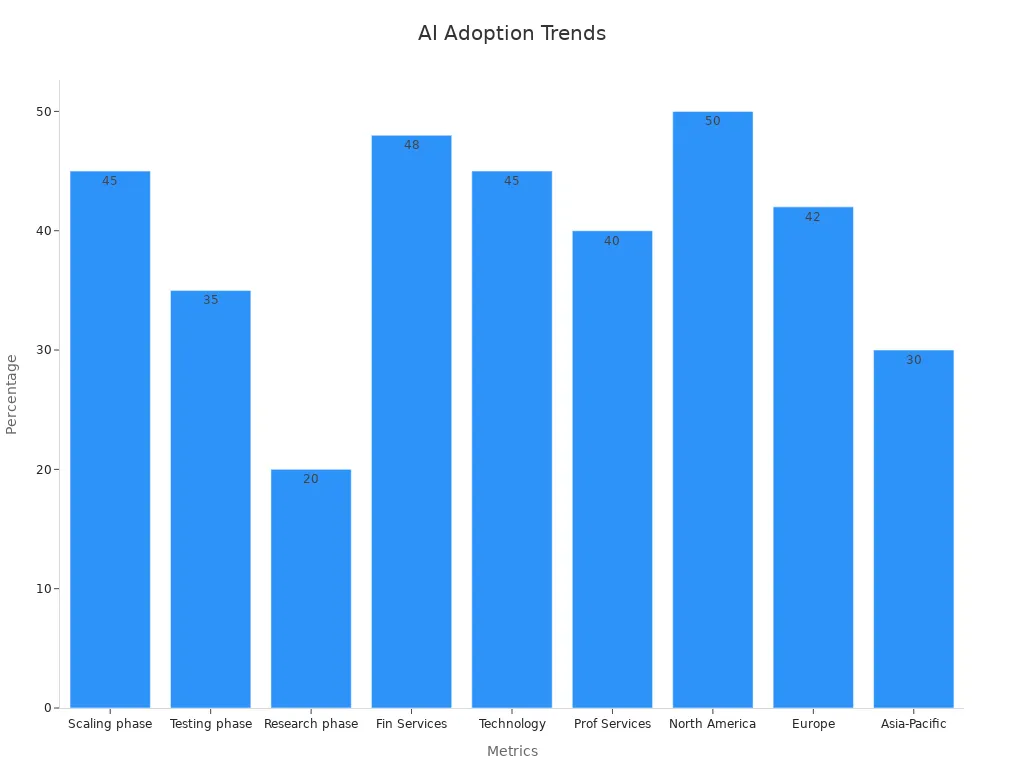
Future Trends in AI and Salary Management
Blockchain Integration for Pay Transparency
Blockchain technology is revolutionizing pay transparency by creating immutable records of employee compensation. This innovation ensures that salary data remains secure, tamper-proof, and accessible for audits. For example, De Beers implemented blockchain to track employee wages, reducing wage disparities by 30% within two years. You can use blockchain to establish trust among employees by providing clear and verifiable salary information.
Blockchain also simplifies compliance with pay equity laws. By maintaining transparent records, you can demonstrate adherence to regulations and avoid legal risks. Employees benefit from this transparency, as they gain confidence in the fairness of their compensation. Adopting blockchain for salary management not only enhances equity but also strengthens your organization’s reputation as a fair employer.
Advanced Predictive Tools for Proactive Equity Management
Predictive analytics is transforming how organizations manage salaries. AI models can simulate various compensation scenarios, helping you optimize budgets and allocate resources strategically. These tools analyze historical data and market trends to forecast salary benchmarks, ensuring you stay competitive. For instance, LSTM networks use deep learning to predict salary growth, while GDP deflator models adjust wages for inflation to reflect real purchasing power.
By leveraging predictive tools, you can anticipate market shifts and address pay disparities before they escalate. Companies using these models adapt to changes 30% faster, reducing costly turnover. As demand for AI talent surges, salaries for roles like machine learning engineers are expected to rise significantly. Predictive analytics provides you with the insights needed to attract and retain top talent in this evolving landscape.
AI’s Role in Diversity, Equity, and Inclusion (DEI)
AI plays a critical role in advancing diversity, equity, and inclusion within salary management. By analyzing pay structures, AI identifies disparities that may affect underrepresented groups. For example, Salesforce used AI-driven tools to uncover pay gaps, investing over $10 million to ensure fairness. Similarly, Microsoft employed AI to analyze compensation data, leading to a 6.8% increase in women in leadership roles.
You can use AI to promote equity by continuously monitoring pay practices and addressing discrepancies. These tools also help you create a more inclusive workplace by ensuring that all employees receive fair compensation. By integrating AI into your DEI initiatives, you foster a culture of fairness and accountability, driving long-term success for your organization.
Preparing for AI-driven salary management by 2025
Preparing for AI-driven salary management requires a proactive approach. You can start by implementing strategies that align with future trends and ensure a smooth transition. Here are some steps to help you get ready:
Use predictive analytics to forecast salary trends. This allows you to stay competitive and adjust compensation based on market dynamics.
Automate compensation reviews to save time and improve accuracy. Automated systems reduce errors and ensure fair pay practices.
Establish robust data collection and quality standards. High-quality data ensures that AI tools provide reliable insights.
Organizations that adopt these strategies often see significant improvements. For example, a tech firm used AI tools to assess employee contributions dynamically. This approach personalized compensation packages based on individual performance. As a result, the company increased employee retention rates by 15%.
AI for pay equity analysis also enhances your ability to manage salaries effectively. By personalizing compensation strategies, you can address pay disparities and improve employee satisfaction. These tools analyze performance data and market trends, helping you make informed decisions. Employees feel valued when their contributions are recognized, which fosters loyalty and trust.
To prepare for 2025, focus on building a strong foundation for AI integration. Start by training your HR team to use AI tools effectively. Invest in technology that aligns with your organization's goals. Regularly review your compensation policies to ensure they remain fair and competitive. By taking these steps, you can create a workplace where equity and transparency thrive.
Tip: Begin small by automating one aspect of salary management, such as pay audits. Gradually expand AI usage as your team becomes more comfortable with the technology.
AI for pay equity analysis transforms how organizations address salary disparities. It enables faster audits, accurate pay gap detection, and proactive adjustments. These tools foster fairness, transparency, and trust, creating workplaces where employees feel valued. By adopting AI-driven solutions, you stay competitive in a rapidly evolving market while ensuring compliance with pay equity laws.
To leverage AI effectively, focus on actionable steps backed by proven metrics. Establish a strong technical foundation to achieve faster compliance reporting. Implement data governance frameworks to improve pay gap identification and predictive modeling accuracy. Transform processes to reduce HR workloads and enhance equity assessments. The table below highlights key strategies and their success metrics:
Actionable Steps | Evidence Metrics |
|---|---|
Establishing a strong technical foundation | 40% faster compliance reporting |
Data governance frameworks | 38% improvement in identifying pay gaps |
42% better predictive modeling for pay adjustments | |
98% data accuracy through automated validation | |
Methodology & Management | 65% higher success rates in AI deployment |
Process Transformation | 55% higher AI adoption rates |
35% reduction in HR workload | |
50% improvement in pay equity assessments | |
65% greater accuracy in pay disparity detection |
By integrating these strategies, you create a workplace that prioritizes equity and transparency. Employees trust compensation decisions when they see data-backed processes in action. This trust drives engagement, retention, and overall organizational success.
Tip: Begin by automating pay audits and gradually expand AI usage across salary management processes. This approach ensures a smooth transition and maximizes the benefits of AI-driven solutions.
FAQ
1. How does AI detect pay disparities?
AI analyzes large datasets to identify patterns and anomalies in salaries. It compares compensation across roles, genders, and demographics to highlight gaps. This process ensures you can pinpoint inequities quickly and accurately.
2. Can small businesses use AI for pay equity?
Yes, AI tools are scalable and accessible for businesses of all sizes. Many platforms offer affordable solutions tailored to small organizations. These tools help you ensure fair pay practices without requiring extensive resources.
3. Is AI reliable for reducing unconscious bias?
AI minimizes unconscious bias by relying on data instead of human judgment. It evaluates salaries objectively, ensuring decisions are based on facts. However, you must ensure the data used is free from bias to achieve accurate results.
4. What industries benefit most from AI-driven pay equity?
Industries with large workforces, like technology, retail, and healthcare, benefit significantly. AI helps these sectors manage complex pay structures and ensures compliance with regulations. However, any industry can use AI to improve fairness.
5. How can you start using AI for pay equity?
Begin by conducting a pay audit using AI tools. Use the insights to address disparities and implement continuous monitoring. Start small, like automating salary reviews, and expand as your team becomes comfortable with the technology.
Tip: Choose AI tools that align with your organization’s goals. Look for platforms offering user-friendly interfaces and robust analytics.
See Also
Enhance Employee Performance Through Effective Talent Management Solutions
Celebrating HR Innovation and Excellence at the 2024 Sirius Awards
Achieving Recruitment Success Through AI Tools: MokaHR's Strategy
From recruiting candidates to onboarding new team members, MokaHR gives your company everything you need to be great at hiring.
Subscribe for more information

